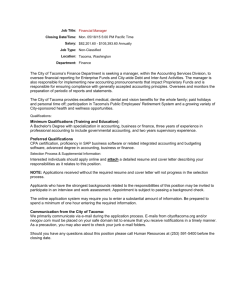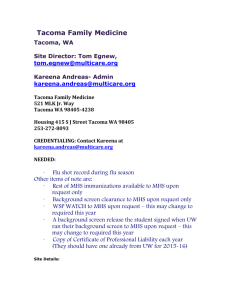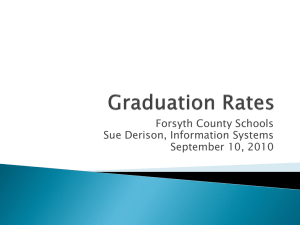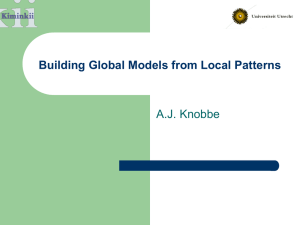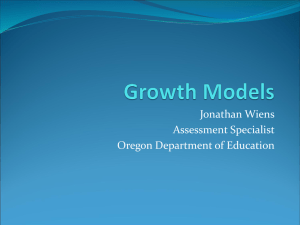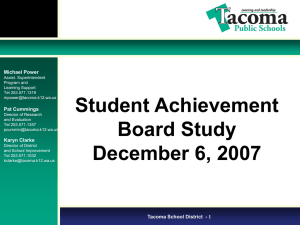AYP to AMO – 2012 ESEA Update January 20, 2013
advertisement
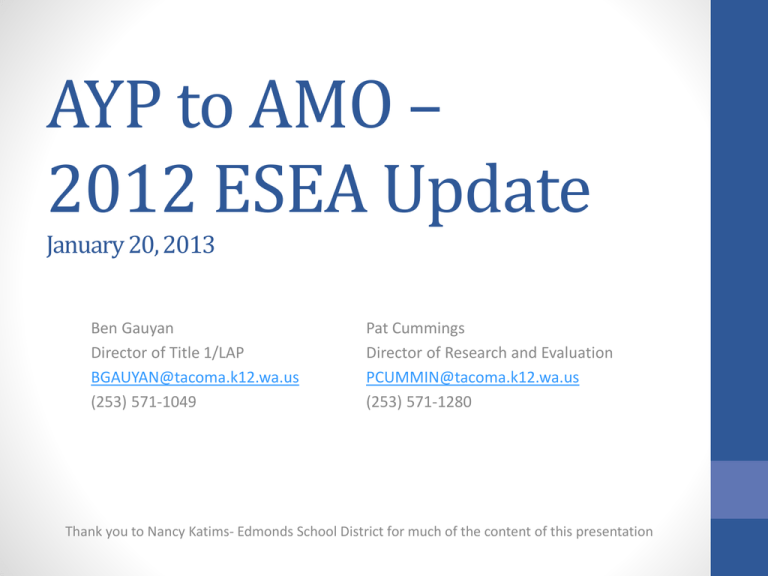
AYP to AMO – 2012 ESEA Update January 20, 2013 Ben Gauyan Director of Title 1/LAP BGAUYAN@tacoma.k12.wa.us (253) 571-1049 Pat Cummings Director of Research and Evaluation PCUMMIN@tacoma.k12.wa.us (253) 571-1280 Thank you to Nancy Katims- Edmonds School District for much of the content of this presentation Background • The federal government granted Washington State a flexibility waiver from the original ESEA No Child Left Behind (NCLB) requirements, including the calculation of Adequate Yearly Progress (AYP). • The changes in the accountability system take effect starting this school year. 2 Background -- To get waiver, states must address three priorities Priority 1: Ensure college- and career-ready expectations for all students Washington state is addressing this priority by adopting: • Common Core State Standards [CCSS] • Smarter Balanced Assessment [SBA] 3 …three priorities continued Priority 2: Support effective instruction and leadership Washington state is addressing this priority by implementing the: • Teacher and Principal Evaluation Project [TPEP] 4 …three priorities continued Priority 3: Implement state-developed system of differentiated recognition, accountability, and support Washington state is addressing this priority by adopting a new accountability system. 5 What has not changed • Goals are still determined for: • Performance on state assessments • Participation in state assessments • Unexcused absence rate for elementary and middle schools • Graduation rates for high schools -- for all sub-groups (ethnicity groups, English language learners, special education, poverty) • Performance is still determined by scores for continuously enrolled students. 6 What has changed • Add two more ethnic groups to sub-groups: • Asian/Pacific Islander subgroup split into two subgroups • “Two or More Races” subgroup added • Annual Measureable Objectives (AMOs) replace AYP goals: • By Spring 2017 reduce by half the proficiency gap between each group’s 2011 level and 100% proficiency • Add equal increments (1/6 of overall target) to create annual targets between 2011 and 2017 • Result in unique annual targets for each subgroup, school, district, and state. • Do not include a margin of error 7 STATE Uniform Bar GOALS Under Old NCLB Requirements 8 Example: Sample High School - 10th Grade Reading 1. 20% met standard in 2011 2. 80% did not meet standard 3. The goal is to decrease the percent not meeting standard by half in six year (40%) 9 Example: Sample High School - 10th Grade Reading 4. Therefore the goal in 2017 is 60% meeting standard (20% baseline + 40% growth = 60%) 10 What has changed • Elimination of: • Sanctions on Title I schools • Classification of schools in “School Improvement Status” • Public listing of schools that did not make AYP • New classification of Title I schools: • Priority • Focus • Emerging • Reward 11 PRIORITY, FOCUS, & EMERGING SCHOOLS – Cohort 1 Category PRIORITY FOCUS EMERGING Description (Based on 2009 -2011 Data) • Lowest performing in all students group over 3 years • Can include Title I-eligible secondary schools that graduate students if grad rate < 60% • 46 (5%) schools in state • • • • Lowest performing subgroups over 3 years Title I schools only 92 (10%) schools in state Tacoma has two Focus Schools • Includes next 5% up from bottom of Priority Schools list (46 schools) and next 10% up from bottom of Focus Schools list (92 schools) • Tacoma has seven Emerging-Focus schools 12 Priority, Focus, and Emerging Schools Focus: Based on “Subgroup” Performance Priority: Based on “All Students” Performance Next 10% (N=92) Next 5% (N=46) Lowest 5% (N=46) Lowest 10% (N = 92) Emerging: Next 5% of Priority and 10% of Focus Total N = 138 13 REWARD SCHOOLS – Cohort 1 Category HIGHEST PERFORMING TITLE I SCHOOLS* Description (Based on 2009 -2011 Data) • Title I schools only • Met AYP in “all students” and/or all subgroups for 3 years in both R and M • Up to 92 (10%) Title I schools showing greatest HIGH-PROGRESS improvement and performance in R/M or graduation rates TITLE I over 3 years SCHOOLS* • Tacoma did not have a Rewards school * School cannot have significant gaps among subgroups and cannot be a Focus or Emerging School. 14 Other Details • Cohort 1 schools are based on 2009-2011 data and will remain in these categories for the 2012-13 school year. • Spring 2012 assessment results will determined Cohort 2 schools in these categories and will be used for 2013-14. • Cohort 1 schools were determined using “N-size” of 30 as minimum number of students for a cell to be counted. Beginning with 2012 data, the “N-size” will change from 30 to 20. 15 Other Details • AMO calculations will be on State Report Card website for all schools. • State Achievement Index data will be published in late December/early January for all schools similar to the last two years. 16 AMO calculations on State Report Card website 17 AMO calculations on State Report Card website 18 State Achievement Index https://eds.ospi.k12.wa.us/WAI/IndexReport/dropdown 19 2012–13 Waiver Tasks for State • The State Board of Education (SBE) and OSPI are required to submit a revised accountability system request, which is likely to include growth data. • Legislature must pass a law to require focused teacher evaluations to use student growth as a significant factor. • State must establish rules regarding use of student growth as a significant factor in teacher and principal evaluation and support systems. 20

